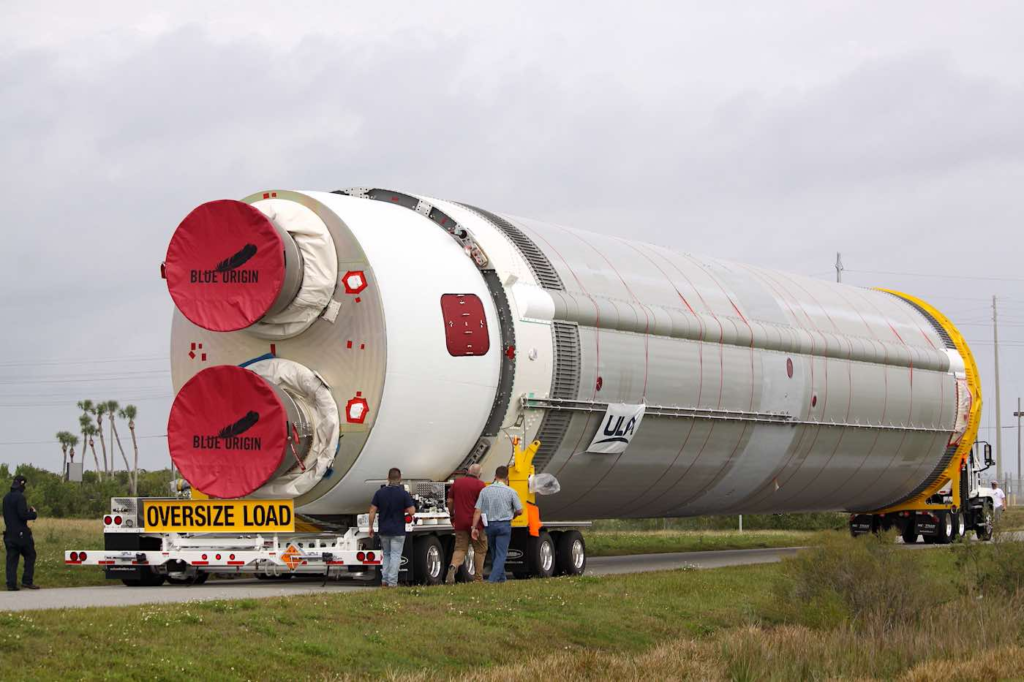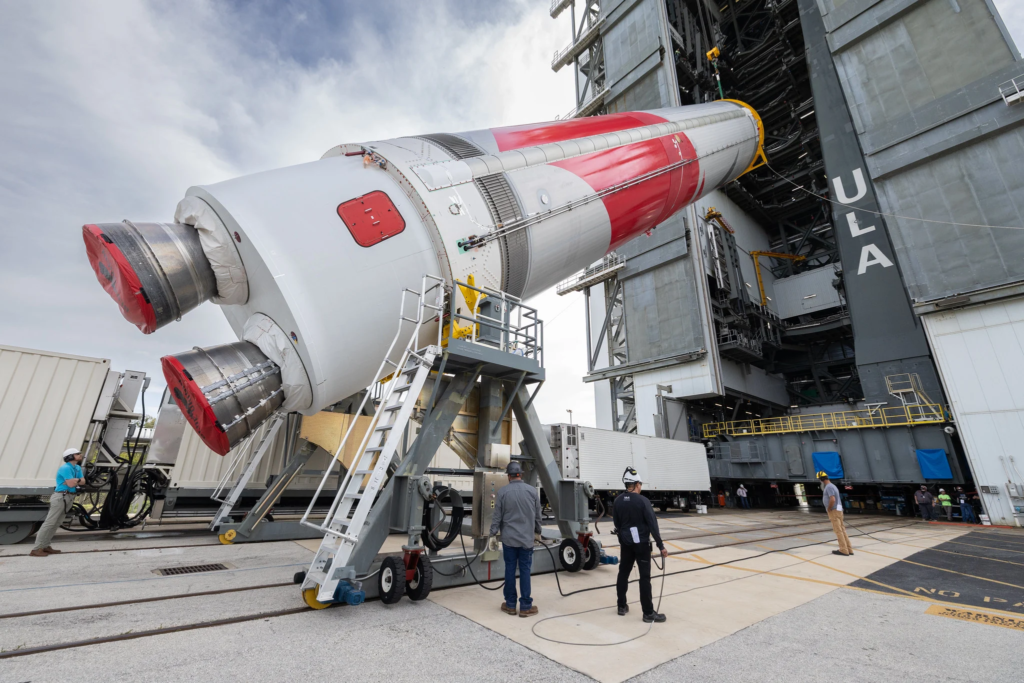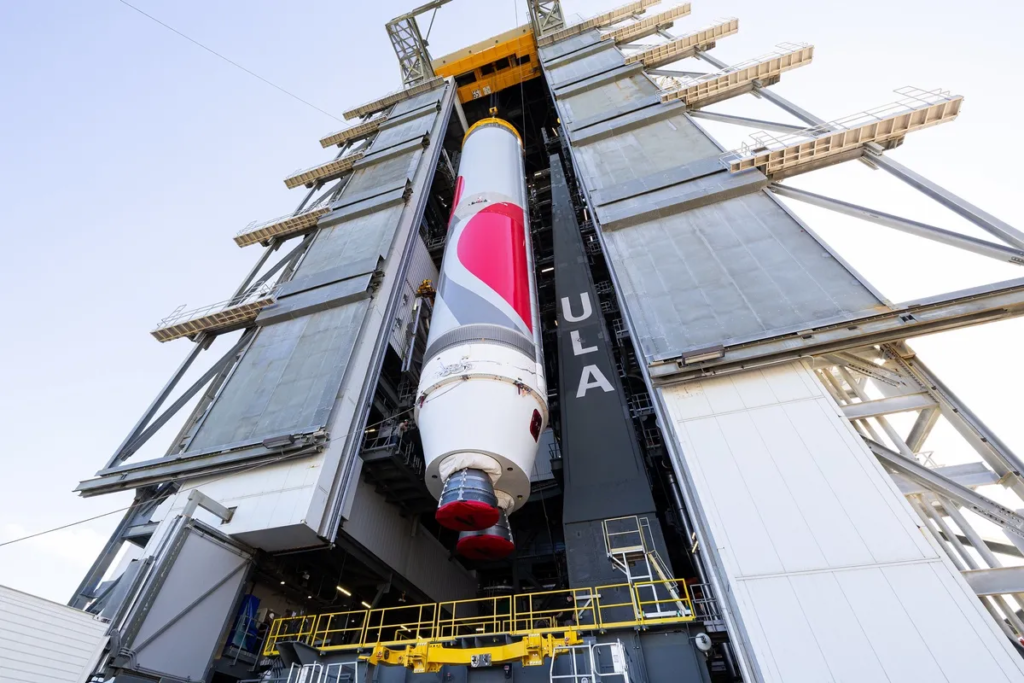
The First Launch of ULA’s Vulcan Has Been Delayed
ULA’s Vulcan Centaur has been trying to launch for a few years now. Unfortunately for the rocket, a host of different issues and complications have come up during its nearly decade long development. Right now the rocket is closer than ever, however, it just recently was delayed again with the explosion of a separate upper stage and core testing that still needs to be completed.
Recently ULA CEO Tory Bruno confirmed that the launch scheduled to happen in early May about one week away, will now take off in June or even July. While the rocket is at the pad and the payloads are ready, a final flight readiness firing among other checks is necessary prior. All of which pushing back this maiden flight more than ULA had hoped for.
This being said, the maiden flight of any rocket often runs into delays and gets pushed back quite a bit. Vulcan is no different as it features a bunch of new hardware including two BE-4 engines getting ready to fly for the first time ever. Here I will go more in-depth into the delay of Vulcan’s maiden flight, why this mission is so important, what to expect in the coming weeks, and more.
Confirmed Delays

Earlier this month when asked whether or not they were still aiming for a launch on May 4th, Tory responded “No. Can’t make the 4th.” and then specified, “June/July”. In reality, the company still has a decent amount of work left that could push these dates back even further depending on the results.
The last major update and test on Vulcan was over a month ago in the middle of March. Here the company completed tanking demonstrations at Cape Canaveral Space Force Station, Florida. Specifically, the pathfinder tests filled the Vulcan first stage and Centaur V upper stage with cryogenic propellant on separate days to validate performance of the stages, Vulcan Launch Platform (VLP), Space Launch Complex-41 facilities, and ground support systems. The tests, which also verified countdown steps, procedures, and timelines, were successfully performed on March 10 on the Vulcan booster stage and March 16 on Centaur V.
In the time since then, only one major event happened which was the explosion of a separate Vulcan upper stage. On April 13th Tory Bruno tweeted mentioning, “Outside of the test rig/ stand. Test article is inside (you can’t see it). Hydrogen leak. H2 accumulated inside the rig. Found an ignition source. Burned fast. Over pressure caved in our forward dome and damaged the rig.” This included a short video close up of the explosion. While not ideal, Tory made it clear that this will not and hasn’t negatively affected the first launch of Vulcan.
The next step in the countdown to the inaugural launch includes conducting a Wet Dress Rehearsal (WDR) to practice the day-of-launch activities and then performing a Flight Readiness Firing (FRF) to complete the full Terminal Countdown sequence, ignite the engines and demonstrate a hot-fire abort recycle and safing. After the FRF, the rocket will return to the VIF for the installation of two solid rocket boosters and its payload for launch. So far, we haven’t seen either of these final tests completed. Based on other information such as the payloads being ready, it seems that everything is in place and the first launch will be dependent on how fast these tests can be completed. Starting next month in May, we can expect to receive updates of a successful wet dress rehearsal followed by a static fire by late May or early June.
It’s important to point out that for this maiden flight, Vulcan will be carrying three payloads to variable orbits, with one headed to the moon. Peregrine, a lunar lander from aerospace and robotics company Astrobotic Technology, will be the launch’s primary payload, and has a significant impact on the launch date. Only a handful of days each month are available to launch Peregrine into its needed trajectory to get to the moon. This means that missing a date by a few days could delay the launch for additional weeks even if the rocket is ready. Based on all this information and the final tests that need to be completed, a realistic launch date of Vulcan is early July assuming the tests go well. If during the static fire, the rocket experiences any anomaly it could cause even bigger delays and push the launch back months.
Years In The Making

Vulcan has had quite a bumpy ride on its journey to the maiden flight. Starting in September 2018, ULA announced the selection of the Blue Origin BE-4 engine for Vulcan’s booster. Just one month later, the USAF released an NSSL launch service agreement with new requirements, delaying Vulcan’s initial launch to April 2021, after an earlier postponement to 2020. In late 2020, ULA said BE-4 engine delivery was expected in mid-2021, and that the Vulcan’s first launch would not happen before the end of 2021. Not long after Astrobotic reported that they needed more time to prepare Peregrine, delaying the first flight of Vulcan to 2022 and later to 2023. The Government Accountability Office (GAO) also stated that the first-stage engine was experiencing technical difficulties, and may not be qualified in time to support a Vulcan launch in 2021. Most recently, Vulcan was expected to arrive at the launch site in November and complete testing in December for an early launch this year. Now we know that the earliest the rocket will lift off is June but more likely July.
In total, the Certification-1 (Cert-1) launch will deliver two Project Kuiper demonstration satellites into low Earth orbit, place the Astrobotic Peregrine commercial lunar lander in a highly elliptical orbit more than 225,000 miles (360,000 km) above Earth to intercept the Moon, and carry a Celestis Memorial Spaceflight Payload beyond the Earth-Moon system to orbit the Sun forever. Most importantly, this commercial mission is part of ULA’s requirement to meet the U.S. Space Force certification of its new launch vehicle. Mark Peller, vice president of Major Development, stated “We are committed to ensuring we fly the first certification mission and stay on schedule to achieve U.S. Space Force certification of Vulcan in advance of our first national security space mission in 4th quarter 2023.” However, these delays are putting this timeline at risk.
Tory Bruno and ULA are pushing to fly two missions by the fall of 2023 so they can complete the military’s certification process and conduct Vulcan’s first national defense mission for the US Space Force during the fourth quarter of 2023.
The Vulcan rocket is a big part of ULA’s future and they plan to launch it very frequently in the coming years. “We have to ramp up,” Bruno said. “Before the end of 2025 we expect to be really at a tempo, which is flying a couple of times a month, every two weeks.” This type of launch cadence that Bruno is talking about would be very impressive for Vulcan. The rocket after all is expendable but they plan to change that in the coming years.
For power, Vulcan uses two Blue Origin BE-4 engines. In addition, Vulcan integrates up to six Northrop Grumman Graphite Epoxy Motor (GEM) 63XL Solid Rocket Boosters (SRBs). They are constructed out of a graphite-epoxy composite with the throttle profile designed into the propellant grain. Vulcan will rely on two RL10C engines to power its second stage. The RL10 boasts a precision control system and restart capability to accurately place payloads into orbit.
The part that ULA wants to reuse in the future is the BE-4 engines. Recently Tory Bruno said, “In terms of our engine recovery, that is going to happen within a handful of years. I don’t want to say exactly when because it’s part of the contract we have with one of our customers at this time, and we’re not releasing the details of that. But it will take a couple of years to actually be reusing the engine. You will see us potentially do more demonstrations,” Bruno said. “We’ll be collecting environmental data to see booster experiences. We’ll recover engines and look at them. And then eventually we’ll have the confidence to recover them, inspect them, and then reuse them. And so that will happen in this window of a few years, but it’s too early at this moment for me to say exactly when. But you’ll see that activity ramp up.”
As more and more launch vehicles within the space industry switch to either partial or full reusability, it will get much harder for entirely expendable rockets to compete price-wise with the competition. ULA knows that saving the two BE-4 engines each launch could help them not only save a lot of money but improve the time between each launch.
Not long ago Bruno commented, “We could not be more excited to be this close to seeing Vulcan lift off on its inaugural flight. Vulcan’s high energy design coupled with innovative technology provides one scalable system for all missions and will transform the future of space launch. This has been an incredible journey to get to this point and I am so proud of the development team,” said Bruno. “We look forward to the first flight as Vulcan offers all customers higher performance and greater affordability while continuing to deliver our unmatched reliability.”
Conclusion
ULA has been trying to launch Vulcan for a long time now. Between the BE-4 engine, payload delays, and now more testing, the rocket has continually been pushed back. Thankfully, we have a new date and likely launch timeline of June or July. We will have to wait and see how it progresses and the impact it has on the space industry.
